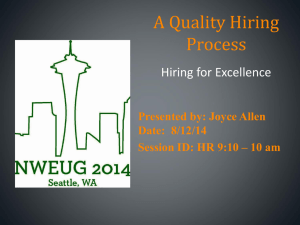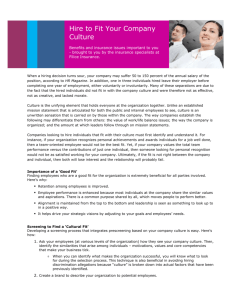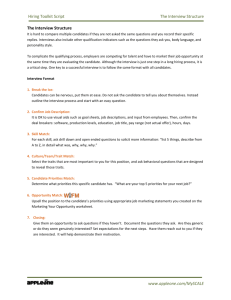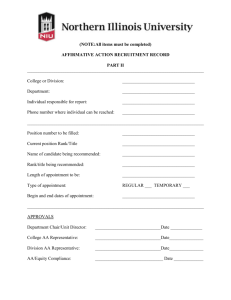The Hiring Process
advertisement
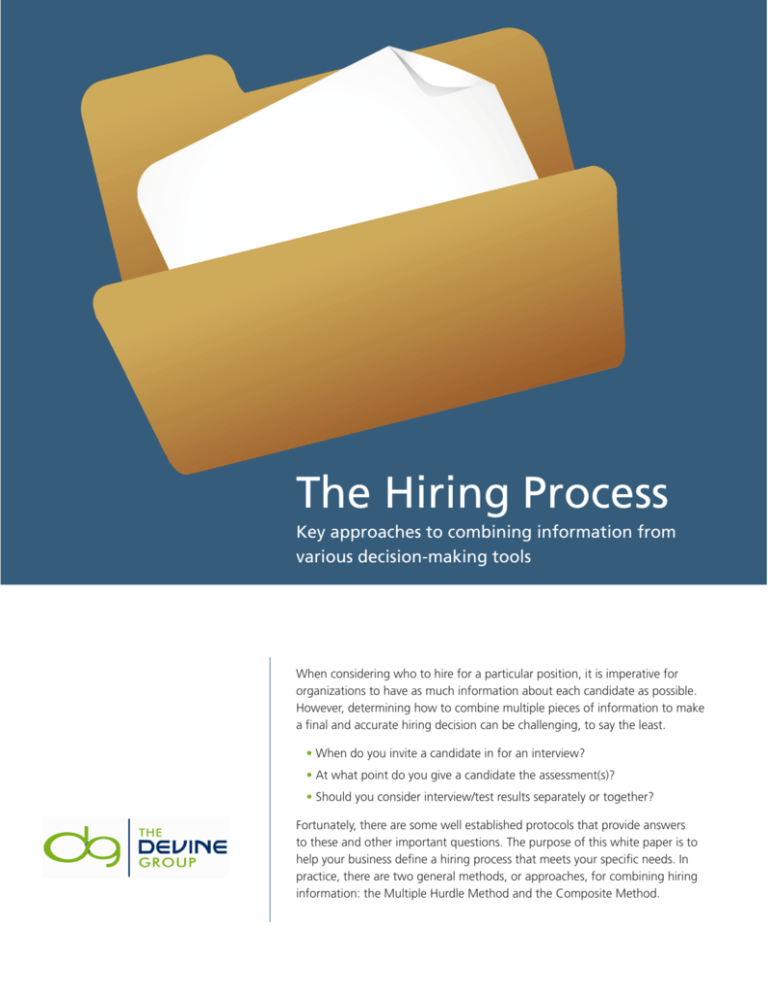
The Hiring Process Key approaches to combining information from various decision-making tools When considering who to hire for a particular position, it is imperative for organizations to have as much information about each candidate as possible. However, determining how to combine multiple pieces of information to make a final and accurate hiring decision can be challenging, to say the least. • When do you invite a candidate in for an interview? • At what point do you give a candidate the assessment(s)? • Should you consider interview/test results separately or together? Fortunately, there are some well established protocols that provide answers to these and other important questions. The purpose of this white paper is to help your business define a hiring process that meets your specific needs. In practice, there are two general methods, or approaches, for combining hiring information: the Multiple Hurdle Method and the Composite Method. The Multiple Hurdle Method is particulary appealing in situations where a large applicant pool exists for a relatively small number of openings. Multiple Hurdle Method Sometimes called the “multiple cutoff” or “funnel method,” this approach involves the administration of decision-making tools sequentially with the elimination of candidates at each stage who do not score at a satisfactory level. 500 Application Initial interview 200 Testing 100 Work simulation 50 Final interview Decision 20 500 200 100 50 20 10 10 In the example above, applications are used to screen-out the majority of candidates (i.e., from 500 candidates to 200), followed by an initial interview or phone screen, employment testing and so on. The Multiple Hurdle Method is particularly appealing in situations where a large applicant pool exists for a relatively small number of openings. In a case like this, it is simply too costly and time-consuming to put all the candidates through all steps in the hiring process. When determining the sequence of decision-making tools, it is important to begin with tools that validly screen out a large number of applicants at a relatively low cost to the organization. Applications, skills inventories, telephone screening interviews and online testing are all good options for that purpose. Tools that are costly and time-consuming to administer, such as simulations and interviews by hiring managers, are usually placed near the bottom of the funnel and used for making the final decision. There are two basic options for applying a Multiple Hurdle Method. The first is to screen individuals using a decision-making tool (e.g., application, phone interview, test score) and then eliminate that information from the next step in the process (i.e., it no longer is considered). The second approach is to use the tool for eliminating candidates, but then carry that information forward to be considered in the next step of the decision process. For example, test or simulation information could be used to eliminate a certain number of candidates, but then carried forward and considered along with a final interview to make the hiring decision. 7755 Montgomery Road, Suite 180, Cincinnati, Ohio 45236 www.devinegroup.com Composite Method The Composite Method consists of having candidates complete all of the hiring tools (i.e., application, interview, assessment) and then combining results for decision-making purposes. The advantage here is that each tool provides some unique information, so by considering them together you can have a more complete overall picture of each candidate. This is often called a “compensatory” method because high scores on some tools can compensate or “make up” for lower scores on other tools. The advantage here is that each tool provides some unique information, so by considering them together, you can have a more complete picture of each candidate. There are several approaches to applying the Composite Method. The first and least complex methodology is to simply sum the scores of the various tools to derive a total score that becomes the basis for decision making. While the adding of scores is simple and straightforward, it can also produce total scores that are distorted or improperly weighted. This is particularly true when the different tools are scored on scales that vary substantially. For example, you may supply a test on which a candidate can score from 0 to 35. However, the interview scores may range from only 1 to 10. If you just add these two scores together, the test will count for more than the interview because the scoring scale is larger. The next level of composite scoring is meant to overcome the problem of differing scale ranges. In this approach, raw scores are converted to some form of standard scale before they are combined. While the discussion of standard scores and normal distribution theory is beyond the scope of this paper, a simplified variation of this concept is presented on the next page. 7755 Montgomery Road, Suite 180, Cincinnati, Ohio 45236 www.devinegroup.com This approach also allows for the weighting of different assessment tools based on their relative importance. In this example, three assessment tools were used for input in the decision process. Converted scores were established by dividing the raw score distribution into five categories (i.e., top 20 percentile, next 20 percentile and so on). This approach also allows for the weighting of different assessment tools based on their relative importance. In our example, Mechanical Reasoning was given a double weight. The final and most sophisticated approach for combining various tools is the use of multiple correlation and regression weights to establish “best-fit” prediction of job performance. This mathematically precise methodology assigns a weight to each tool based on its statistical relationship with job performance and its relationship with other battery measures. Of course, this approach assumes that an appropriate criterion-related validation study to develop the model has been conducted and that each candidate completes all components of the hiring process. 7755 Montgomery Road, Suite 180, Cincinnati, Ohio 45236 www.devinegroup.com Hybrid approaches It is, of course, possible to combine the multiple hurdle and composite methods in a variety of ways. For example, rather than using a hiring tool for decision making at one step and then discarding it from further consideration, it is possible to use the tool for screening-out a subset of individuals and then pulling that information forward to be considered as part of the decision process at the next step in the Multiple Hurdle. It is also possible to use various screening tools early on in the Multiple Hurdle process, but then combine more than one tool at a critical stage in the hiring process. Hybrids, or combinations of the two approaches, can also be used to create a methodology that fits your specific needs. 500 200 100 50 20 10 7755 Montgomery Road, Suite 180, Cincinnati, Ohio 45236 www.devinegroup.com It’s important to apply thoughtful consideration to your hiring process— this will provide a consistent and robust route to identifying the best talent. Final ranking of candidates Regardless of the details, a basic hiring method needs to be determined. Typically, if the tools you are using are valid, candidates who score higher will display higher levels of performance on the job. Therefore, we suggest you rate or rank candidates according to their results. Hiring decisions (offers) should be made to the top (highest-rated or ranked) candidate and then on down the list. This approach maximizes utility and is preferred over methods such as choosing any candidate who scores above a minimum cutoff or selecting one candidate from a list of three to five. However, cutoff points are useful in terms of deciding a minimum acceptable level of scoring below which an offer will not be made. Practical considerations often require that candidates are grouped. For example, a hiring manager may insist that human resources provide him/her with the top three candidates for a final interview. Finally, placing scores into groupings may be needed in some cases to help meet equal employment and affirmative action goals. Overall, your hiring process should be designed to meet your needs and hiring objectives. It is difficult to balance applicant flow with job openings while trying to place high-quality candidates. However, understanding the various approaches and applying thoughtful consideration to your hiring process will provide a consistent and robust route to identifying the best talent. 7755 Montgomery Road, Suite 180, Cincinnati, Ohio 45236 www.devinegroup.com

